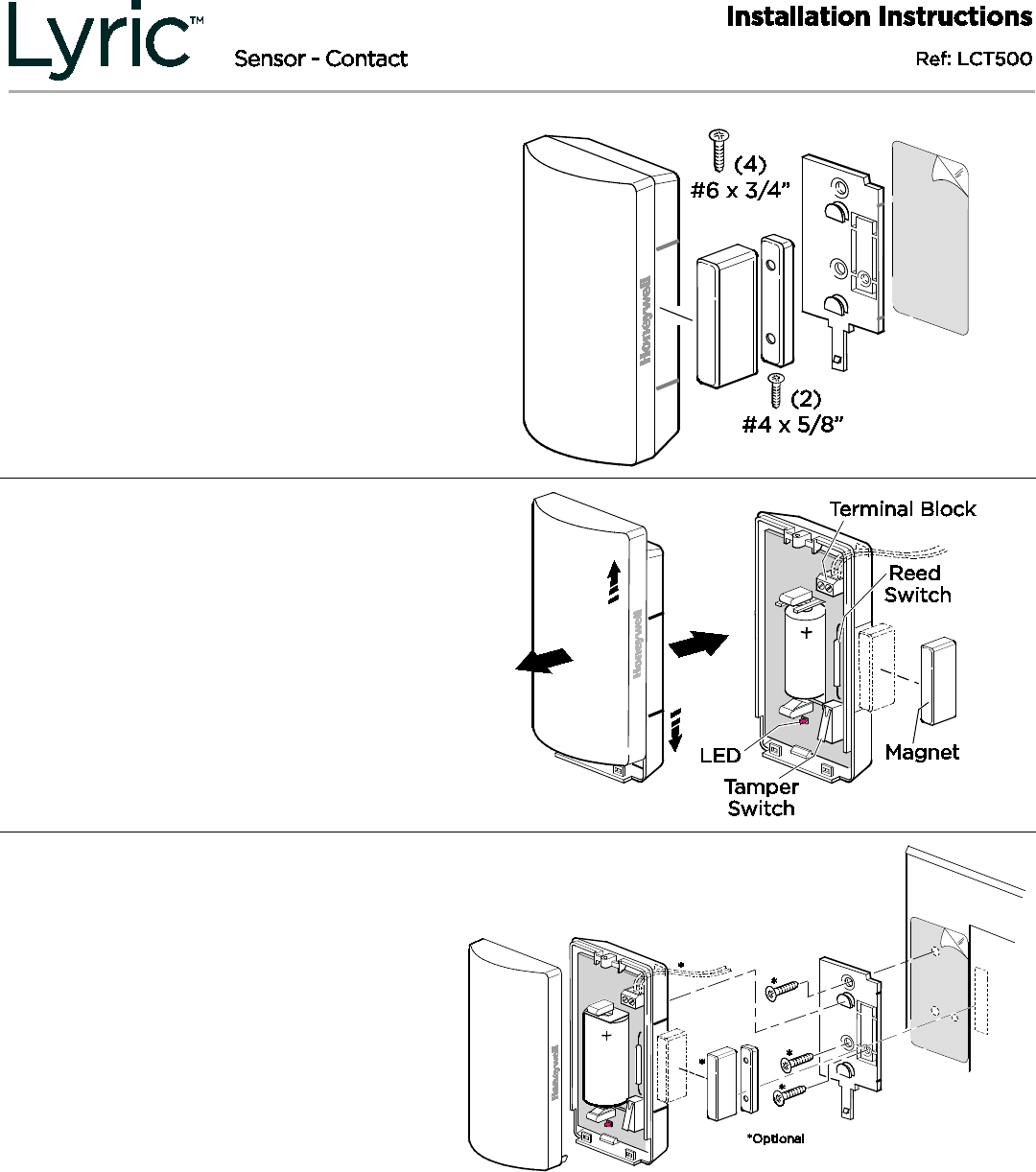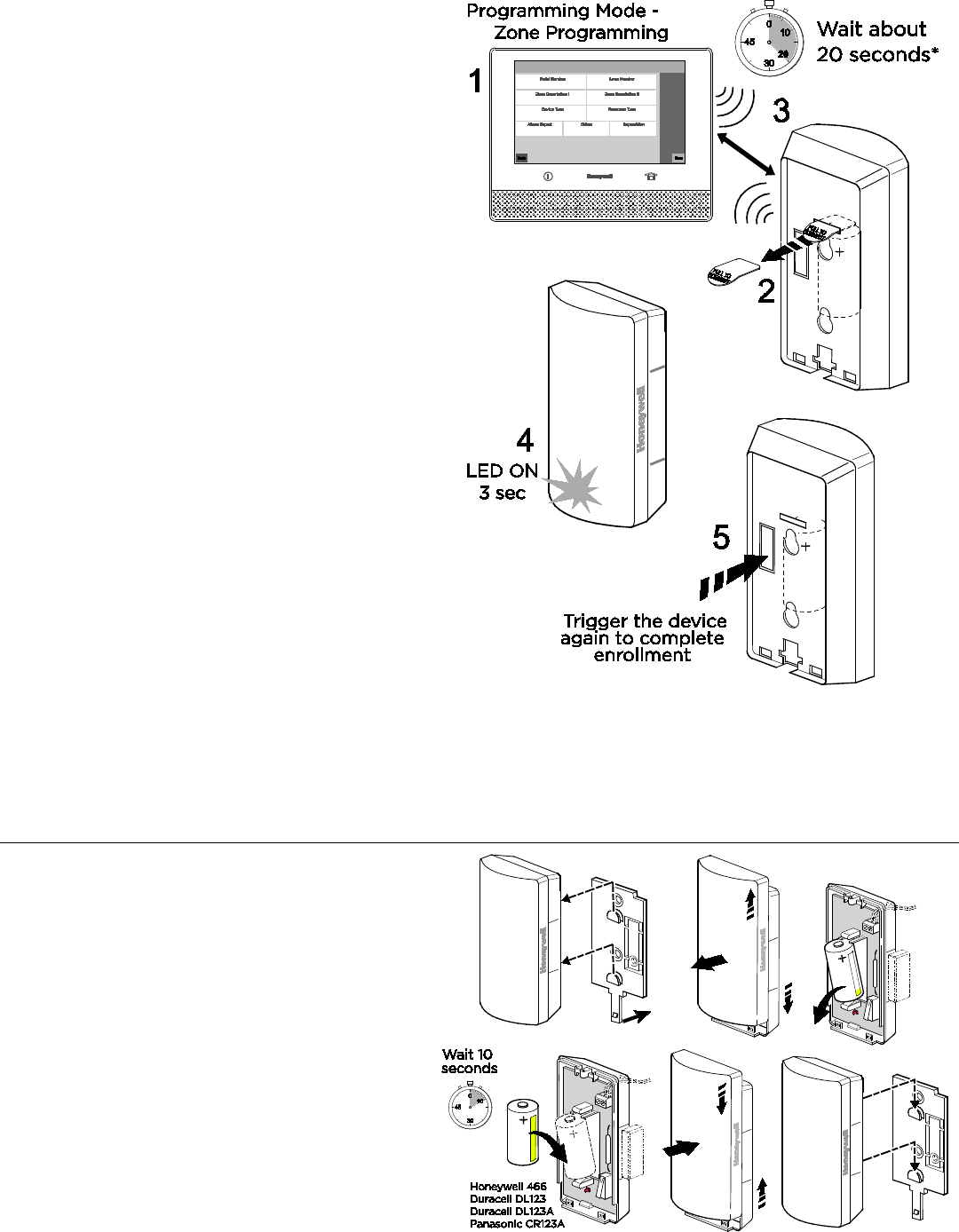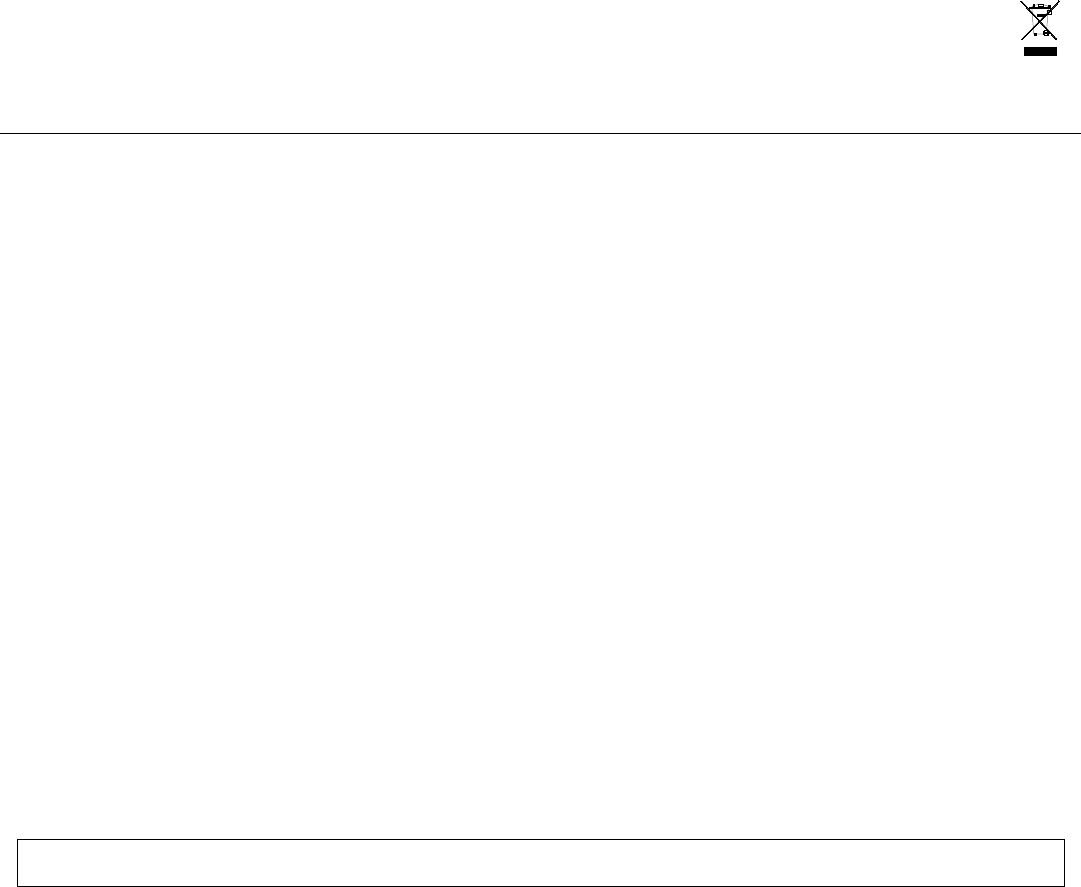Ademco 8DLRF6C Lyric Smart Peripheral - Contact User Manual Installation Guide
Honeywell International Inc. Lyric Smart Peripheral - Contact Installation Guide
Ademco >
Contents
Installation Guide

The LCT500 is a wireless door / window
contact intended for use with Honeywell
controls that support SiX™ series devices.
Open the LCT500
• Firmly slide the top and bottom housings
in opposite directions and pull them apart
to open the device.
Mounting
The LCT500 can be mounted with several
options:
• Installation with magnet: Make gap is
0.75"; Break gap is 1.30".
• Optional Wiring for Service loops:
a) surface wiring
b) concealed wiring
Note: Wiring limit is 3ft.
• Range: TBD
Note
: After enrolling and before mounting
the LCT500 permanently, conduct Go/No Go
tests (see controller’s instructions) to verify
adequate signal strength. Adjust the device
location and orientation as necessary.
BETA DRAFT II’s – 05/27/15
PLEASE GO TO THE BOTTOM OF
THE NEXT PAGE FOR FCC/IC
AGENCY STATEMENTS

Enroll and Set Up
Note:
The LCT500 can be enrolled and
programmed before or after installation.
1. Set the Lyric Smart Controller in
Programming Mode and go to Zone
Programming. Select Add New, then Serial
Number. Follow the control’s instructions to
begin enrollment.
2. Pull the battery tab to activate the LCT500
and begin the enrollment process.
3. The LED flashes (about 20 seconds*) during
enrollment.
• The device sends the device MAC ID
address and Services information to the
control.
• The control registers the device and
displays the transmitter data on screen.
4. When done, the LED is ON for 3 seconds
and the control beeps to confirm enrollment.
5. If the device is not successfully enrolled
during the enrollment period, the LED turns
off and the device powers down. Activate a
tamper, wired service (loop) or the reed
switch to restart the enrollment process.
Note
: Once enrolled in a system, the LCT500 cannot
be used with another controller until it is removed
from the current controller. See the Controller’s
instructions for details.
Follow instructions in the Controller’s
programming guide to program the LCT500
services:
• Cover and Wall tamper switches
• Reed switch / Magnet
• External device connected / Terminal block
(unsupervised)
• Temperature sensor (this service is set by
the panel)
Battery Replacement
• Push the bottom latch of the mounting
bracket back to disengage it. Then slide
the back housing, up and out to remove it
from the mounting bracket.
• Slide the front and back housings in
opposite directions and pull the housings
apart.
• Remove the battery, wait 10 seconds, then
insert a new battery. Recommended
batteries:
Panasonic CR123A Honeywell 466
Duracell DL123 Duracell DL123A
• Place the front and back housings together
and slide them together as shown.
BATTERY CAUTION
: Risk of fire, explosion and burns.
Do not recharge, disassemble, heat above 212° F (100° C)
or incinerate. Dispose of used batteries promptly. Keep
away from children.
*Note: Depending on the signal
strength between the device and the
control, the enrollment period may
take longer than 20 seconds.

Specifications:
Battery
: 1 x 3V Lithium, Honeywell 466, Panasonic CR123A, Duracell DL123
or DL123A
Tamper
: Cover and Wall – reported separately to panel.
RF Frequency
: 2.4GHz
Operating Temperature
: 32° – 122° F / 0° – 50° C
(Agency Compliance 32° – 120° F / 0° – 49° C)
Relative Humidity
: Up to 95% (Agency Compliance - up to 93%),
non-condensing
Dimensions
: 1” H x 3.13” L x 1.61” W / 25.5 mm H x 79.5 mm L x 41 mm W
Approval Listings:
FCC / IC
ETL Listed to UL 634
cETL Listed to ULC/ORD C634
RoHS
Product must be tested at
least once each year
FEDERAL COMMUNICATIONS COMMISSION & INDUSTRY CANADA STATEMENTS
The user shall not make any changes or modifications to the equipment unless authorized by the Installation Instructions or User's Manual. Unauthorized
changes or modifications could void the user's authority to operate the equipment.
CLASS B DIGITAL DEVICE STATEMENT
This equipment has been tested to FCC requirements and has been found acceptable for use. The FCC requires the following statement for your
information: This equipment generates and uses radio frequency energy and if not installed and used properly, that is, in strict accordance with the
manufacturer's instructions, may cause interference to radio and television reception. It has been type tested and found to comply with the limits for a
Class B computing device in accordance with the specifications in Part 15 of FCC Rules, which are designed to provide reasonable protection against such
interference in a residential installation. However, there is no guarantee that interference will not occur in a particular installation. If this equipment does
cause interference to radio or television reception, which can be determined by turning the equipment off and on, the user is encouraged to try to correct
the interference by one or more of the following measures:
• If using an indoor antenna, have a quality outdoor antenna installed.
• Reorient the receiving antenna until interference is reduced or eliminated.
• Move the radio or television receiver away from the receiver/control.
• Move the antenna leads away from any wire runs to the receiver/control.
• Plug the receiver/control into a different outlet so that it and the radio or television receiver are on different branch circuits.
• Consult the dealer or an experienced radio/TV technician for help.
INDUSTRY CANADA CLASS B STATEMENT
This Class B digital apparatus complies with Canadian ICES-003.
Cet appareil numérique de la classe B est conforme à la norme NMB-003 du Canada.
FCC / IC STATEMENT
This device complies with Part 15 of the FCC Rules, and RSS-210 of Industry Canada. Operation is subject to the following two conditions: (1) This device
may not cause harmful interference, and (2) This device must accept any interference received, including interference that may cause undesired operation.
Cet appareil est conforme à la partie 15 des règles de la FCC & de RSS-210 des Industries Canada. Son fonctionnement est soumis aux conditions suivantes:
(1) Cet appareil ne doit pas causer d’interférences nuisibles. (2) Cet appareil doit accepter toute interférence reçue y compris les interférences causant une
reception indésirable.
RF Exposure
Warning – The antenna(s) used for this device must be installed to provide a separation distance of at least 7.8 inches (20 cm) from all persons and must
not be co-located or operating in conjunction with any other antenna or transmitter except in accordance with FCC multi-transmitter product procedures.
Mise en Garde
Exposition aux Frequences Radio: L'antenne (s) utilisée pour cet émetteur doit être installée à une distance de séparation d'au moins 7,8 pouces (20 cm)
de toutes les personnes.
Support and Warranty
REFER TO THE INSTALLATION INSTRUCTIONS FOR THE CONTROL WITH WHICH THIS DEVICE IS USED, FOR DETAILS REGARDING
LIMITATIONS OF THE ENTIRE ALARM SYSTEM.
For the latest documentation and online support information, please go to:
https://mywebtech.honeywell.com/
For the latest U.S. warranty information, please go to: www.honeywell.com/security/hsc/resources/wa or
Please contact your local authorized Honeywell representative for product warranty information.

2014 Honeywell International Inc. Honeywell and is a
registered trademark of Honeywell International Inc.
All other trademarks are the properties of their respective
owners. All rights reserved.
DOC CODE 128B BAR CODE HERE
P/N 800-19202CT 04/15 Rev BETA
2 Corporate Center Drive, Suite 100
P.O. Box 9040, Melville, NY 11747
www.honeywell.com/security